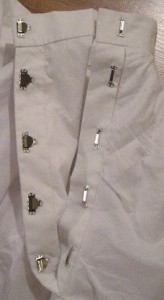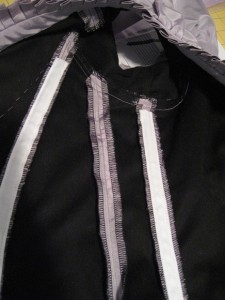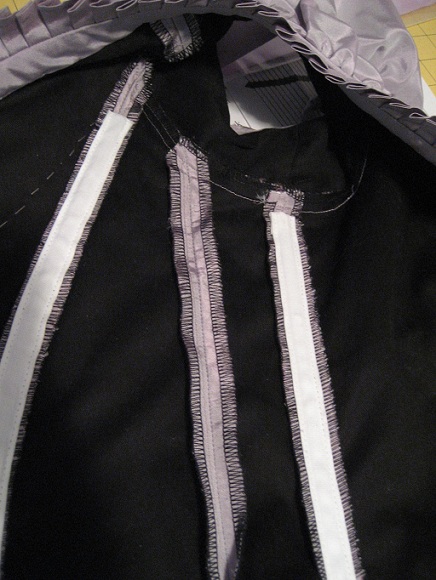
You know the routine – you didn’t allow enough time to finish your dress and now you’re having to cut corners to get it even *wearable.*
I’ve been there. Early on in my costume sewing. Not so bad that I had to be sewn into my dress, but still pushing the clock til it was bruised. I have, however, sewn friends into their bodices. Not something I like or want to repeat.
So I began to notice little areas I could… shall we say… cheat a little in my projects.
I mean, I’m a modern 21st Century girl with a full-time office job, a husband and two furry, attention-deprived (apparently) kitties. Oh, and a house to maintain, extended family to spend time with, a blog to write…. you get the picture. I’m sure you’ve got a long list of responsibilities too.
So while I was balancing all my twirling plates I’d find ways to make my sewing MOVE faster. It’s so annoying to spend an entire Saturday afternoon on pattern alterations only to fall into bed that night cursing the heavens for the speedy passage of time and your inability to get things done quickly.
I have to warn you here, especially if you are a hard core/purist/authentic sewer. I cheat. I use modern methods for my period garments. 99% of them.
In no particular order…
*I serge. Everywhere. Nearly all my seam allowances are covered with those fancy loopy stitches from my Viking 936. I flatline this way. On some edges though, I’ll have to machine baste, like on necklines and hems that will be enclosed in bias. The last thing I serge on my bodices are the armhole seam allowances.

*I use modern interfacing in belts, collars, cuffs and along the back buttonhole openings on Regency gowns. I don’t do this all the time. But when the stash of organdy has run out, well, my hat box full of fusible interfacings will produce something that will work.
*The Assembly Line. Yes, it really does work, and fast!
*The closets full of historical clothing would not be possible without skirt hooks & bars. I should buy stock in Dritz. 56% of my openings are closed with skirt hooks. The other portion with buttons and (machine-made) buttonholes with 7% regular hooks & eyes or thread loops. (75% of statistics are made up on the spot but not my use of these fabulous little notions.)
*Rotary cutters were made for making bias for piping and finishing. I seriously don’t know how the Victorians lived without them.
*”Petticoat ruffles only take 27 hours now and not the grueling 68 it used to take with the new Ruffler foot!” Get it today to speedily set on miles of gorgeous, flittering waves of cotton. My eyes were opened with this. No more two basting stitches, sewing over dental floss or the like. Although on a side note, I still do prefer the look of regular two thread gathering and use it often. Just not on petticoat ruffles that no one sees.
*I use Stitch Witchery, Fray-Check and Fabri-Tac glue.
*Washable fabrics get pre-treated in a washing machine and dryer.
*I apply my boning in its casing to the bodice by machine. (The only part I hand whip is on the dart points.)
*And I use a Sharpie to write sizes on the ends of bones and rows of cut hoop wire.
Of course other modern methods pop up as I’m going along as they usually do. I’m a rogue.
Now that you know some of my 21st C. secrets, please share yours. I know you have them too. 🙂


I love my rolled hem foot for sheer fabrics when I know I won’t be able to get a hand rolled hem done. I’m a huge fan of hooks and bars & my ruffle foot as well.
I use a lot of these short cuts too. Try using the serger to gather ruffles – you can buy a gathering foot for most of them and then you just adjust the settings per the instructions. FAST! The gather has a nice finished edge. I usually sew it upside down on the garment and press it down to cover the serged area. Since it is serged it will not unravel and get stringy. I like the look better than the ruffler foot, and it will do much thicker fabric than the gathering foot. I also figured out how to use a smocking pleater to do cartridge pleats. Granted, you still have to attach them by hand but they are absolutely 100% even and I can pleat up a skirt in about 10 minutes. Downside is it will not do thicker fabrics. I also found this vintage notion called a Clinton Pleat Maker. They are usually a few for sale on Ebay. It is basically a pleating fork but you can adjust it to change the depths of the pleats and it has a built in ruler so you can measure the space between the pleats as you go. Awesome tool! I also use an embroidery machine to fake hand embroidery , wing needles to fake pulled thread work – we are so lucky there such great tools available (vintage and new).
Pleating is the bane of my sewing existence. But alas, I do love the look. Enough so , or sew, heh heh, that I have probably sewn several miles worth of knife pleated frill and trim over the last few years. But a kind friend of mine gifted me a pleating board she made out of card stock last year, and while I still loathe ( yes loathe!) making my miles of pleats, the work goes faster now thanks to it.
I don’t think using a ruffler or machine sewing things is cheating. I inherited a late Victorian sewing machine, and it has a ruffler attachment, though you might not recognise it, and the slim volume on dressmaking food students of the art says to machine whenever you can. I’m sure if our ancestors had access to the same tools we now do, they would have used them.
I agree. Nearly every treadle machine I own came with that neat little black box. My earliest is from 1899 and the feet are pretty rudimentary, but they are there. Great Aunt Cleste did all the sewing for a family of 15 from the time she was old enough to sit at the machine. She told me she cut corners every chance she got and loved her “fancy” Singer.
I swear by my ruffler, my pleater and since I don’t have a server, the zigzag stich. I also love fuzible interface and safety pins. Every outfit I make will always have a safety pin in it, whether it needs or not.
I LOVE my blind hem foot. So fast, so beautiful.
I was a long time Rennie decades before I discovered Victorian wear. As a performer I need costumes I can get into and out of without help, costumes that can stand up to all kinds of weather and everything the public can do to them. I also need to be able to wear garments in all temperature ranges. Enter the costumers’ friend: Velcro. Velcro means that you can put in or take out the fur lining of your cloak in an instant. Velcro means that your pouch can be closed and sealed against light fingers that don’t belong there. Velcro means a lot more.
What do you mean the Tudors and the Victorians didn’t have it? Of course they did. That’s my story and I’m sticking to it.
Next time I’ll tell you all the things safety pins are good for.
It is so refreshing to see someone else admit to cheating. Hurray for sergers, fusible interfacing, zip ties for boning and the ruffler foot.
I found a cheap way to buy boning. If you go to the hardware store and look for Zip Ties (aka Cable Ties). They come from small to 6 feet long. Cut the ends off and they work great. I use them in my Bustle and Lobster tail. If you are using them under very very heavy fabric I double them up. I have not had issues with them dry cracking even when dried in dryer.
Plastic zip ties from walmart make nice boning for bodices. Cheap too. AND I don’t have to wait for it to be shipped to me.
I set my sewing machine to ruffle on it’s own. I set the upper thread at its longest, and the bobbin thread at its shortest (tightest tension)….it makes it a 2:1 ratio of stitiching w/ my Brother machine. Then stitch away…it “automatically” ruffles a length of fabric in no time at all.
In addition to my ruffler foot I also have a gathering foot. I use it all the time for flounce. It makes a nice even gather and if you need to let out or take in your gathered piece it is by a couple of inches not feet.
whopper poppers. use as needed. Packaged bias tape,(i have the bias tape makers,but.. meh… to lazy.) Pre made patterns, I can’t drape,draft,or droop.
oh, and when doing stays. i put the lining on inch by inch instead of cutting out the shapes. actually works better…especially since i can place the bones easier that way
I rarely ever mock up. and once the fashion fabric is cut out, I do the fitting with that and than tuck and pin and just sew over those alterations. it works. when im doing historical stuff, i don’t even measure the round gown on my regency stuff…I put it around me like a towel to make sure what i have will go around my butt and than sew it on. lol and safety pins. I have sewed them into garmets cause i didnt have time to sew the alteration. lol
I cheat where ever possible when it comes to my reenactment clothing. I hem by hand, and any top stitching. But if it is an internal seam you better believe this girl will cut any corner she can. Love your site!
Yea! you are all after my own heart. Whenever you can cheat! If they’d had it they’d of used it!
Exactly.
Agreed. Unless I’m entering the garment in a “period” competition, some of the modern cheats are faster, more stable and longer lasting.
Hey, nothing wrong with “cheating”. When I make Regency dresses, I wear them on a daily basis so I didn’t aim to make them “historically accurate”. My aim is a good well-made, fast to make, durable garment.
I like when seamstresses & tailors can produce beautiful garments using machine & hand-sewing.
When my serger works, it’s a beautiful thing. I love me some serging.
I believe that it depends on what you are aiming to produce. If you are reproducing a museum-quality garment, then use the methods they used in that period. Yet if you want a regular costume or garment, then use modern methods.
I have been known to put my hoops together with duct tape…
I cheat as well. As long as it doesn’t impact the outward appearance I’m game. I used snap tape on an underdress; it was a quick and a secure closure that no one would see. And, like you, Jennifer, I serge where I can.
I am so very relieved to hear you say these things.
I felt so guilty for serging the tops seams of a petticoat…
I sew french seams for my regular seams, but ruffle seams look so dreadful and serging cleans them up so nice.
Hook and eye tape and yes I use skirt hooks and bars too.
Whew…. thanks!
I do most of these too. Fray Check is the only way some of the lighter weight and fray able fabrics made it through multiple events, lol. Thanks!
Oh, and I just finished yards and yards of ruffles for my petticoat. All using my ruffler. And thank God I figured out how to use my rolled hem foot because I wasn’t looking forward to pressing and turning the miles of hem to stitch it.
Hook & eye tape. I just can’t get those individual suckers lined up right. And I internix a snap or two.